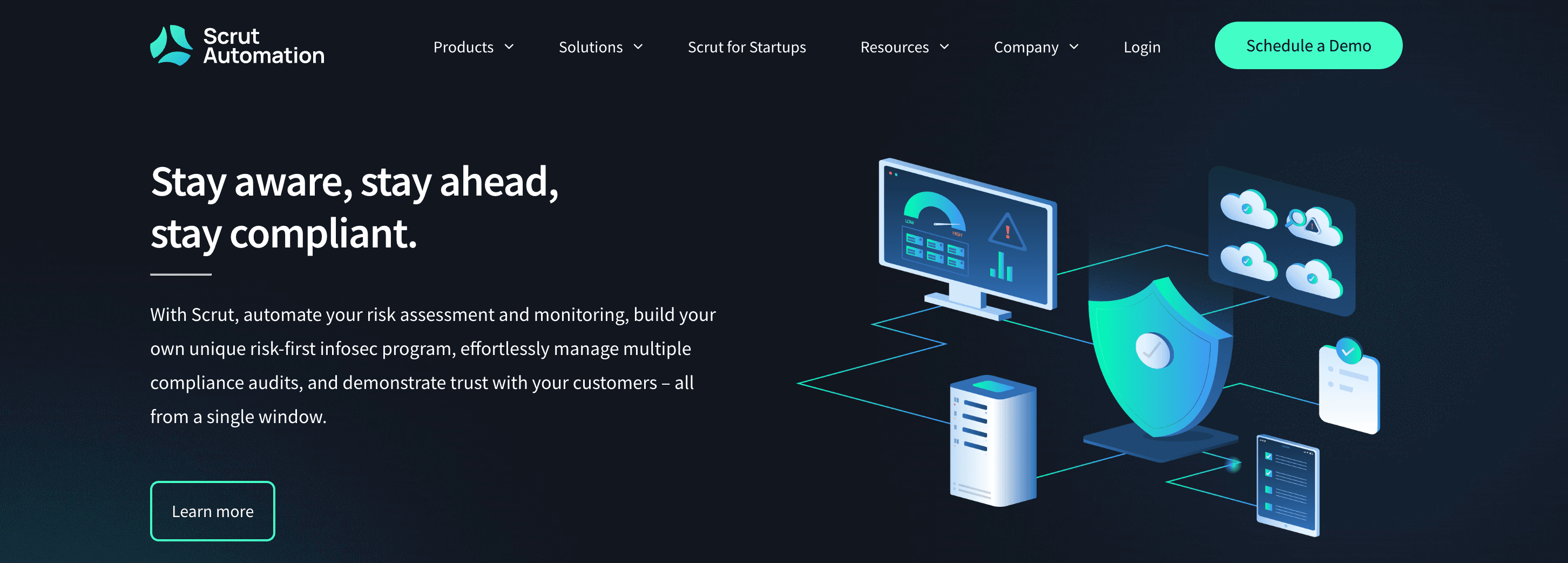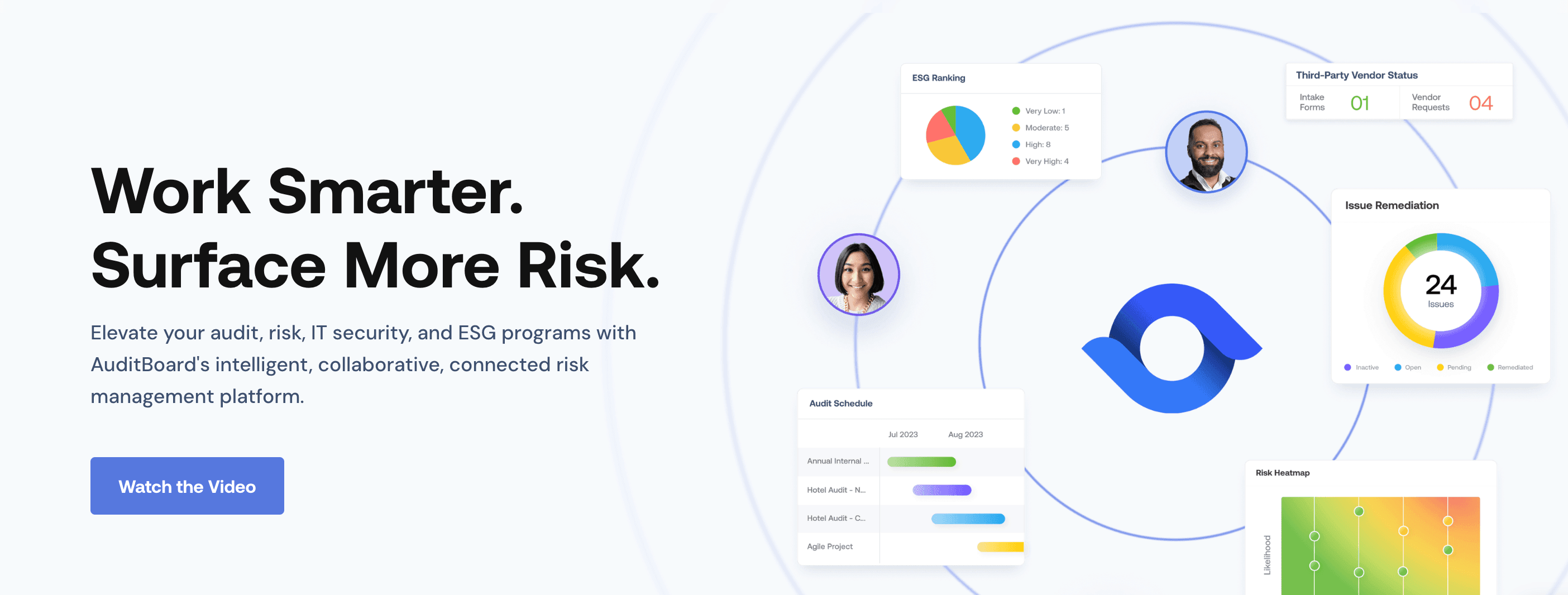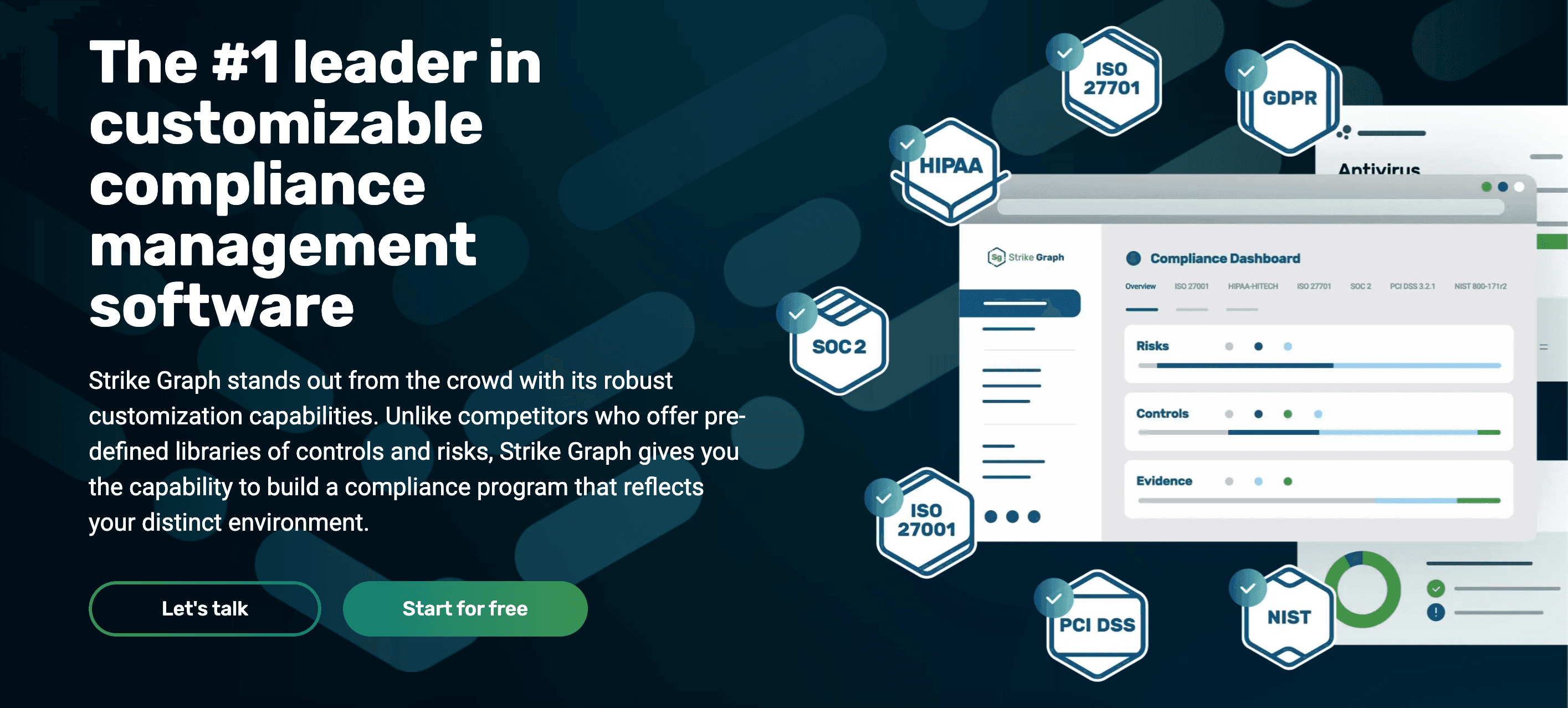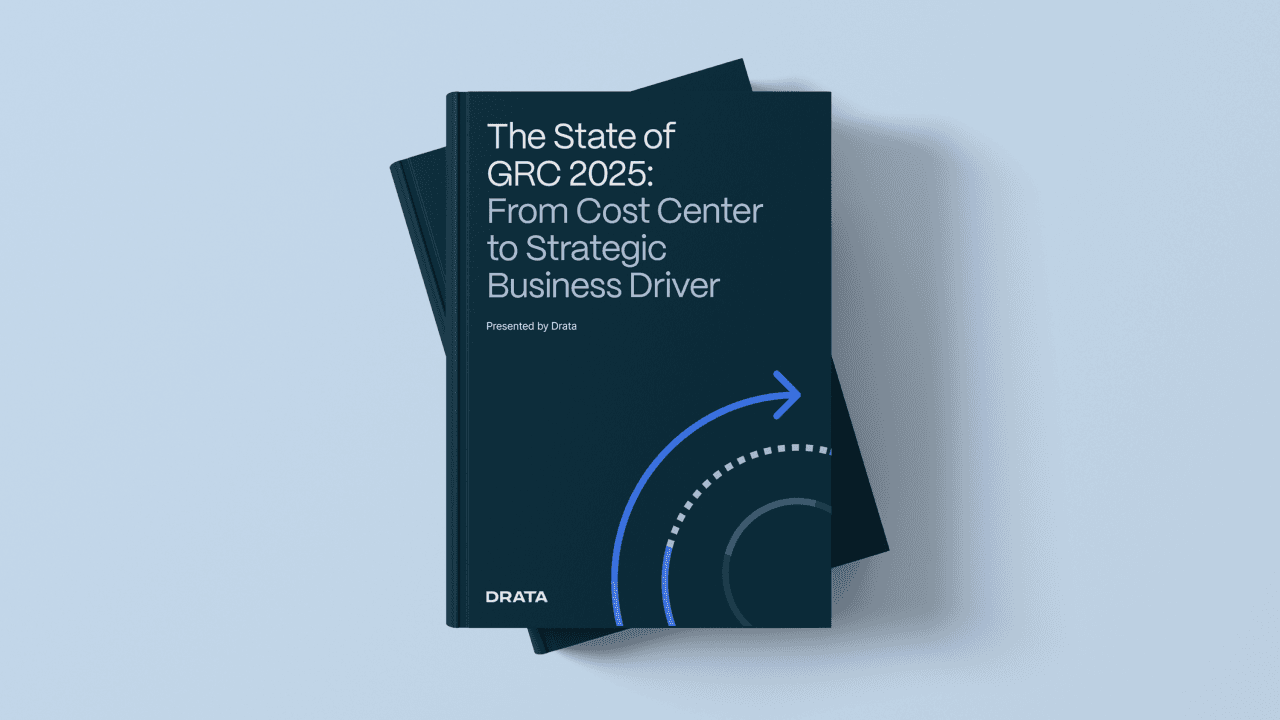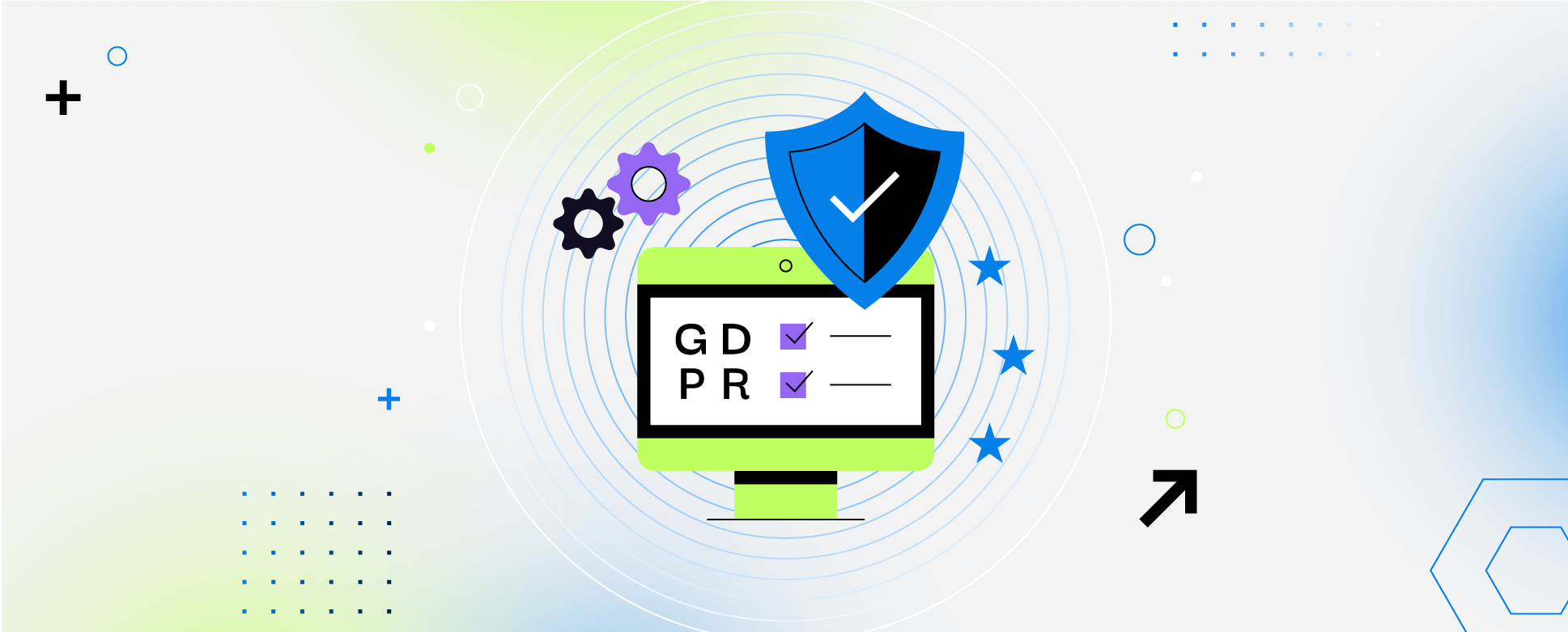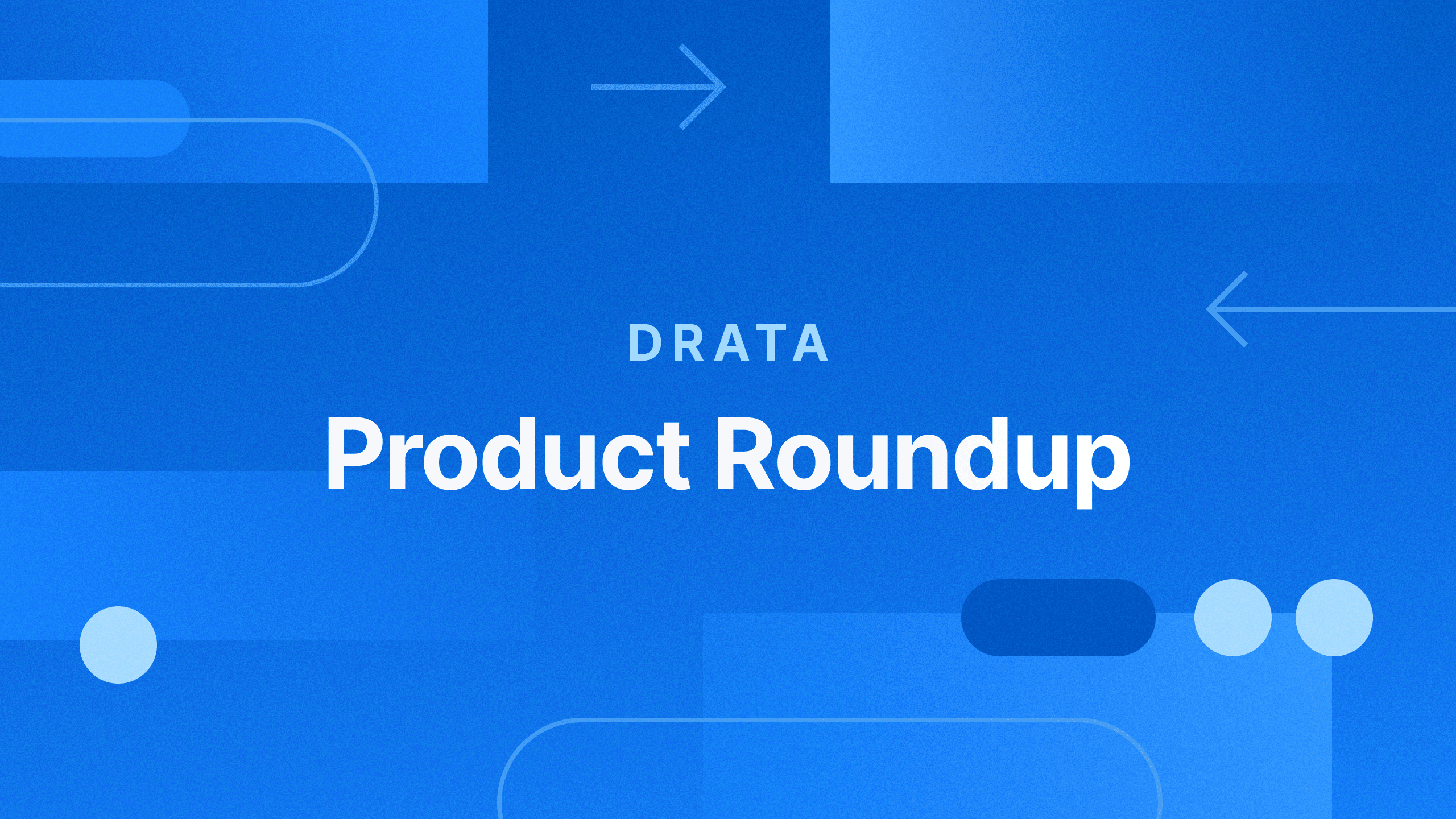Top 10 Sprinto Alternatives + Competitors in 2025
What are the top Sprinto alternatives to consider in 2025? We combed through reviews and features to help you choose the compliance automation solution that will take you further.
Sprinto is a well-known name in the compliance automation space, especially among early-stage startups aiming to get their first SOC 2 report out the door. However, as companies either scale or take a closer look at what’s under the hood, they might decide that Sprinto’s offering doesn’t deliver the flexibility, depth, or long-term support they require.
If you’ve outgrown Sprinto or want to start with a platform that scales from day one, it’s worth evaluating your options. More than helping you pass an audit, your compliance solution should support your entire go-to-market motion, strengthen your security posture, and simplify the complex processes behind risk, access, and trust management.
Below, we break down what to look for in a Sprinto alternative, followed by a detailed review of the top ten competitors in 2025. We examine strengths and tradeoffs, share real user feedback from G2 and Capterra, and help you find the right fit based on your company’s stage, tech stack, and compliance goals.
What to Look for in a Sprinto Alternative
Most compliance tools promise audit readiness, but few deliver the infrastructure to build trust at scale. The best Sprinto alternatives support your growth into new frameworks, markets, and enterprise deals while reducing the overhead that slows your team down.
No matter your growth stage (startup chasing your first big customer or a scaling company), the goal is the same: eliminate the noise, prove your security posture, and keep moving fast. That calls for a platform that’s built for scale, built for security teams, and built to last.
So first, let’s examine the main capabilities you should look for in any Sprinto alternative, and how to spot solutions designed to evolve with your business.
Scalability Across Frameworks
SOC 2 might be the starting point, but it’s rarely the finish line. Cybersecurity and privacy requirements multiply quickly as companies grow (into new markets, verticals, or regions). What begins as a single compliance framework quickly turns into five, ten, or more.
Your compliance platform needs to scale with you. Top solutions support 20+ frameworks out of the box, and more importantly, allow you to reuse controls across frameworks to avoid duplicate work. Say, if you’re pursuing ISO 27001 after SOC 2, you shouldn’t need to re-upload the same policies or configure evidence collection from scratch.
Look for a platform that also supports custom frameworks, so you’re not limited by what’s pre-configured. This becomes even more important as your customers, partners, or regulators introduce unique requirements not covered by standard frameworks.
Deep Automation
Vendors often talk a big automation game. In practice, many stop at templated checklists and basic integrations, which still leave your team chasing screenshots, uploading PDFs, and managing evidence in spreadsheets.
True automation runs deeper. It connects directly to your tech stack (your cloud provider, identity system, ticketing tools, and CI/CD pipeline) to continuously collect evidence, test controls, and alert you when something drifts out of scope. This is how you know your compliance status is always up to date, not just at audit time.
Even better platforms take this further with no-code test builders, custom test logic, and pre-mapped controls across frameworks, so teams can tailor automation to fit the way they actually work. If you’re still manually exporting logs or building reports by hand, that’s not automation. It’s a red flag.
Built-In Risk and Vendor Management
Managing risk and third-party exposure is a core part of any mature security program, but many lightweight compliance management tools treat it as an afterthought.
The strongest platforms integrate risk and vendor management via a live, centralized risk register with pre-mapped threats, custom scoring, and automated treatment plans. Users should be able to assign ownership, track progress, and tie each risk directly to the controls that mitigate it.
For vendors, look for a solution that makes it easy to track vendor impact, send and analyze security questionnaires, and maintain a complete vendor directory. AI-enhanced workflows and automation ensure that vendor reviews are high-quality and fast.
Developer and DevOps Integration
If your compliance tool can’t speak the language of your engineering team, that will inevitably slow you down. Companies need security woven into the development process, not layered on top after the fact.
Leading platforms integrate with your CI/CD pipeline, infrastructure-as-code tools, and cloud providers to enforce compliance earlier in the development lifecycle. That includes flagging misconfigurations in pull requests, running automated tests before code hits production, and providing devs with clear remediation guidance, right in their workflow.
This change from reactive to proactive compliance reduces technical debt, avoids failed audits, and frees up your engineers to build with confidence.
Audit Collaboration Features
An audit isn’t a scavenger hunt (or at least, it shouldn’t be). Chasing down evidence, juggling emails, and managing last-minute requests is a waste of resources, especially if your team is already stretched thin.
Look for a compliance platform with built-in tools for real-time collaboration between you and your auditor. Features like a centralized Audit Hub, secure auditor access, and in-app task tracking help both sides stay aligned from kickoff to final review.
You should be able to see what evidence is requested, upload it directly, and track progress without switching tools. At the same time, auditors should be able to leave comments, approve items, and view past reports, all in one place.
Trust Center for Revenue Enablement
Enterprise buyers expect proof of security before they sign. Without a fast way to share certifications, policies, and audit reports, sales cycles will drag and deals will stall.
The best compliance platforms remove friction from the process. A Trust Center lets your team publish security documentation, show real-time control statuses, and gate access behind an NDA. Prospects can self-serve, your reps can move faster, and your security team avoids repeating the same answers.
You build trust by showing your posture. If your compliance platform doesn’t help accelerate sales, you’re leaving money on the table.
Top 10 Sprinto Alternatives
If Sprinto isn’t the right long-term fit, you're not short on options. The right choice, though, depends on where your company is heading, not just where it is today.
In this section, we look at ten of the strongest alternatives on the market. Tools that support real security outcomes, streamline audits, and adapt as your risk landscape evolves. We’ll highlight what each platform does well, where users hit friction, who they’re best for, and how they stack up on customer satisfaction.
1. Drata
Drata is a top-of-the-line, full-scale Trust Management platform that helps companies build, demonstrate, and scale their security posture. While many tools focus solely on audit prep, Drata supports the full lifecycle of trust, from continuous control monitoring and real-time risk management to vendor due diligence, access reviews, and revenue-enabling transparency through its Trust Center.
Built for security-first organizations, Drata integrates across your tech stack and development workflows to automate compliance and reduce manual overhead. Whether you’re managing one framework or twenty, a single product or a complex portfolio, Drata provides the infrastructure to scale your GRC program without sacrificing speed, clarity, or credibility.
Main Features:
Automated continuous compliance across your cloud, identity, HR, ticketing, and DevOps stack
Trust Center to publish certifications, policies, and live control status, publicly or behind an NDA
Compliance-as-Code to enforce security guardrails in pre-production and CI/CD workflows
Audit Hub for seamless, secure collaboration with auditors inside the platform
Risk Management with pre-mapped threat libraries, scoring, and live treatment tracking
Vendor Risk Management with automated reviews, questionnaires, and AI-driven summaries
Access Reviews that eliminate spreadsheets with live, system-connected user data
20+ Frameworks supported, with overlapping controls to reduce rework
Custom Frameworks to map internal or industry-specific standards
Multi-Workspace Architecture to manage compliance across business units, products, or geographies
AI-powered security assurance, vendor reviews, and continuous monitoring
Ideal For:
Fast-growing startups preparing for enterprise sales, fundraising, or expansion into regulated industries
Enterprises with multiple business units or subsidiaries that need dedicated compliance scopes with centralized oversight
Scaling companies that need to manage multiple frameworks without duplicating effort
Engineering and security teams that want automation built into their CI/CD pipelines, infrastructure, and access controls
Security-first companies looking to consolidate GRC and trust workflows into one system of record
G2 and Capterra Ratings:
2. Vanta
Vanta is often the go-to compliance solution for startups aiming to get SOC 2 ready as quickly as possible. Its interface is clean with a comprehensive integration library and bundled policy templates to help teams build out their compliance program with minimal friction. Many customers appreciate the guided setup and integrated auditor referrals, which make the early stages of compliance more approachable for non-technical teams.
However, Vanta’s simplicity can create issues as companies grow. Customers have reported gaps in audit readiness, limited flexibility across frameworks, and automation that still requires manual uploads or evidence gathering. For teams managing multiple frameworks or maturing into risk and vendor management, these limitations can result in duplicated work and increased overhead.
Main Features:
Pre-built integrations for collecting evidence from tools like AWS, GitHub, and Okta
Policy templates to speed up documentation for common frameworks
Partnered auditor network to guide users through compliance
Continuous monitoring dashboard that flags gaps and tracks progress
Risk registers and vendor assessments
Ideal For:
Startups seeking a fast path to compliance with minimal configuration
Small teams without dedicated security or compliance staff
Founders who want a guided experience with auditor connections included
Companies looking for a lightweight platform to prove initial compliance
G2 and Capterra Ratings:
3. Secureframe
Secureframe is a plug-and-play compliance solution that helps companies get audit-ready quickly with pre-built security controls, policy templates, and dedicated assistance. It supports major frameworks like SOC 2, ISO 27001, HIPAA, and GDPR and provides access to a network of partner auditors. Secureframe’s clean UI and onboarding structure make it approachable for first-time users, particularly those without in-house compliance expertise.
Where Secureframe often draws criticism is in how it handles ongoing program management after the initial setup. Some customers report friction when configuring controls or adapting the platform to their specific processes. Despite praising the support team, other users also cite a lack of clear instructions and limited integration capabilities.
Main Features:
Pre-built integrations for collecting evidence from tools like AWS, Azure, Google Cloud, GitHub, and Okta
Policy templates to accelerate documentation for frameworks like SOC 2, ISO 27001, HIPAA, and PCI DSS
Partnered auditor network with guided readiness support
Continuous monitoring dashboard to track control status and surface outstanding tasks
Ideal For:
Early-stage startups aiming for a fast SOC 2 or ISO 27001 report
Companies with limited in-house security or compliance resources
Teams that prioritize simplicity and guided onboarding over customization
G2 and Capterra Ratings:
Find out how Drata, Vanta, and Secureframe stack up
4. Scrut Automation
Scrut Automation is a GRC platform built with cloud-native companies in mind. It’s designed to help startups and mid-sized teams move quickly through compliance audits while managing ongoing security posture through continuous monitoring, risk assessments, and vendor due diligence. With support for frameworks like SOC 2, ISO 27001, HIPAA, and GDPR, Scrut bundles essential compliance workflows into a lightweight, accessible platform.
That said, several users across both G2 and Capterra mention Scrut can be overwhelming, with one user specifically calling out how they found it “difficult to navigate due to the complexity of its features or integration setup.“ Others also report occasional system performance issues.
Main Features:
Evidence collection via integrations with AWS, GitHub, Google Workspace, Okta, and more
Policy templates for major frameworks, with built-in editor and approval workflows
Risk register with treatment workflows and scoring
Vendor risk assessment tools with questionnaires and document tracking
Continuous compliance dashboards tailored for cloud infrastructure
Ideal For:
Cloud-native startups preparing for SOC 2, ISO 27001, or HIPAA
Companies operating in heavily regulated industries like healthcare, finance, and government contracting
Engineering-led companies that want fast implementation and a narrow scope
G2 and Capterra Ratings:
5. Thoropass
Thoropass, formerly known as Laika, combines software automation with hands-on auditor support. It offers a hybrid approach: automation for evidence collection and control monitoring paired with access to in-house compliance experts and audit delivery. The platform supports frameworks like SOC 2, ISO 27001, HIPAA, GDPR, and PCI DSS and guides teams through their first audit with minimal guesswork.
A big differentiator is Thoropass’s bundled model, as users can manage their compliance program and complete the audit process all within the same ecosystem. It’s a tight integration that can simplify the process for smaller teams, but it also comes with trade-offs.
Some users report inconsistencies in the auditing experience, noting that they were paired with different auditors throughout a single engagement and sometimes received conflicting advice. Others pointed out product issues, including UI bugs or alert notifications that couldn’t be disabled until escalated and fixed.
Main Features:
Access to in-house audit services and compliance experts
Task-based UI for tracking progress toward audit readiness
Basic risk register and vendor management capabilities
Bundled software and audit engagements
Ideal For:
Startups or mid-sized teams new to SOC 2 or ISO 27001
Companies seeking an all-in-one audit and software solution
Security-light teams that want hands-on compliance support
G2 and Capterra Ratings:
6. Hyperproof
Hyperproof was created for companies with complex compliance needs and mature security programs. Unlike lightweight audit-prep tools, Hyperproof focuses on long-term program management across risk, compliance, and assurance workflows. It supports a wide range of frameworks and provides built-in tools for mapping controls, tracking risks, assigning ownership, and producing audit-ready reports.
Hyperproof wins on flexibility. Teams can design custom workflows, link controls across frameworks, and manage overlapping requirements from a single interface. It’s well-suited for companies juggling multiple frameworks across different departments or geographies.
However, that same flexibility introduces complexity. Reviewers mention that Hyperproof can feel overwhelming, particularly for teams without a dedicated GRC function. With so many options, new users may struggle to understand which policies and procedures to implement or how to structure their program efficiently. Automation is another area where reviewers see room for improvement, with some expressing a desire for deeper connections with DevOps tools, and more proactive communication features such as email notifications for auditor comments.
Main Features:
Framework and control mapping across business units and departments
Centralized risk register with scoring, treatment plans, and ownership tracking
Task management, document versioning, and cross-team workflows
Auditor access for evidence review and control validation
Integration with cloud, identity, and ticketing systems (depth varies by tool)
Ideal For:
Mid-market and enterprise companies managing multiple frameworks
GRC teams with internal program structure and technical bandwidth
Companies seeking a centralized GRC platform rather than a point solution
G2 and Capterra Ratings:
7. AuditBoard
Built for enterprise orgs managing high-volume workflows, AuditBoard’s bread and butter is a modular structure that enables teams to centralize documentation, track findings, automate workflows, and generate audit-ready reports from one system.
The platform is great for cross-functional collaboration. It comes with a centralized space for teams to work together, document processes, and manage controls across frameworks (something many large organizations struggle to unify). AuditBoard’s dashboarding and reporting tools are also robust and help users surface insights across business units and risk domains.
Still, usability remains a consistent drawback across reviews. Users describe the product as not intuitive with a steep learning curve and a cumbersome interface. Others note challenges with document management, and some features shown during demos did not match real-world flexibility.
Main Features:
Dedicated modules for SOX, internal audit, IT risk, and enterprise risk management
Cross-functional collaboration and centralized documentation tools
Workflow automation for audit testing, issue tracking, and control assessments
Integration with major enterprise systems (ERP, IAM, ticketing platforms)
AI-powered technology to scale resourcing planning and summarize audit findings
Ideal For:
Large enterprises with complex audit and compliance programs
Teams with formal risk governance structures and internal audit departments
Organizations prioritizing process standardization and documentation at scale
Companies with resources for structured implementation and training
G2 and Capterra Ratings:
8. Scytale
Scytale combines software automation with dedicated customer support in order to guide teams from readiness through audit with less friction and fewer resources.
It provides integrations for evidence collection, a policy management module, and compliance tracking dashboards. Scytale also emphasizes white-glove onboarding and expert support, which appeals to startups without in-house GRC expertise. For smaller teams navigating compliance for the first time, the platform presents an approachable, guided path to audit readiness.
That said, Scytale is still maturing, both in terms of product stability and depth. Reviewers call out bugs and inconsistencies in basic functionality, like assigning policies to employees or completing integrations. Others mention a lack of features they expected to be standard: missing integrations, no support for private policies, and an over-reliance on manual configuration.
Main Features:
Integrations for AWS, GitHub, Google Workspace, and other core systems
Pre-built policy templates and employee policy management workflows
Guided onboarding with access to compliance experts
Evidence collection, task management, and progress tracking
Support for auditor collaboration and certification readiness
Ideal For:
Startups pursuing their first compliance audit with minimal internal support
Teams that prioritize white-glove onboarding and guided help
Organizations with simple architectures
G2 and Capterra Ratings:
9. Lacework FortiCNAPP
Lacework FortiCNAPP is a cloud-native application protection platform that extends beyond compliance into security monitoring, threat detection, and vulnerability management. It's built for engineering and security teams that need to monitor infrastructure at scale, especially across multi-cloud environments like AWS, Azure, and GCP.
Lacework’s compliance capabilities are part of Fortinet’s larger offering. They help teams continuously assess configuration drift, enforce cloud security posture management (CSPM), and track alignment with standards like SOC 2, ISO 27001, PCI DSS, and NIST.
As for shortcomings, some users report that Lacework’s dashboard can be difficult to navigate, making it harder to quickly surface specific compliance or security information. Others also struggle with creating custom dashboards and cite scalability limitations in AWS integrations.
Main Features:
Cloud security posture management (CSPM) for AWS, Azure, and GCP
Continuous monitoring and configuration drift detection
Threat detection, anomaly detection, and event correlation
Infrastructure monitoring and vulnerability management
Native integrations with AWS Control Tower, Kubernetes, and CI/CD pipelines
Ideal For:
Security-forward organizations operating in multi-cloud environments
Engineering and DevOps teams that want to integrate compliance into existing observability workflows
Companies that want compliance tooling bundled with security analytics
Enterprises with dedicated security staff and complex infrastructure
G2 and Capterra Ratings:
10. StrikeGraph
Strike Graph is an AI-powered GRC solution that aims to simplify the audit readiness process for organizations of all sizes. It emphasizes quick onboarding, guided workflows, and AI-assisted risk and control mapping to reduce time spent on manual prep. It also includes a control library, built-in policy templates, and real-time audit readiness scores to help teams monitor progress.
Users do report UX frustrations, such as losing their place when the platform unexpectedly reloads or redirects to the homepage. Several reviewers point out that Strike Graph could use improvements such as control and evidence descriptions and vulnerability scanning results, among others.
Main Features:
Evidence collection and task tracking across frameworks
Dashboards for audit readiness and project management
Built-in audit prep functionality and partner network access
AI-assisted control and risk mapping
Ideal For:
Businesses with unique security requirements that need tailored compliance programs
Teams aiming to use AI to streamline compliance tasks and minimize manual effort
Organizations managing several frameworks at once that need a centralized, adaptable solution
G2 and Capterra Ratings:
An Overview of Sprinto Alternatives
Compare the top Sprinto alternatives at a glance with the table below:
Platform | Best For (Company Size + Industry) | Best For (Teams + Roles) |
Drata | High-growth startups, mid-market, and enterprise organizations looking for end-to-end compliance and GRC automation | CISOs, GRC leads, and security or engineering teams seeking real-time monitoring and support for the full trust lifecycle |
Vanta | Startups and mid-market companies looking for a fast, lightweight entry into SOC 2 or ISO 27001 | Founders, ops, and security teams managing compliance for the first time |
Secureframe | Startups and mid-sized companies that want an easy-to-use platform to achieve compliance quickly | Founders and engineering leads with limited compliance expertise looking for streamlined onboarding and automated workflows |
Scrut Automation | Companies in highly-regulated industries or managing cloud infrastructure | Compliance, risk, and cloud security teams that need real-time controls and structured risk programs |
Thoropass | SMBs and mid-market orgs that want audit readiness software and access to in-house auditors | Companies new to compliance looking for hands-on support and bundled software-audit delivery |
Hyperproof | Mature organizations managing multiple frameworks that need both automation and customizable workflows | GRC professionals, security and compliance teams balancing tailored controls with automation |
Scytale | SMBs that want a simplified platform and guided experience for frameworks like SOC 2 and ISO 27001 | Ops teams seeking step-by-step workflows and responsive support |
Lacework | Enterprises running cloud infrastructure at scale that need unified visibility across environments | DevOps and SecOps teams prioritizing multi-cloud monitoring and anomaly detection |
AuditBoard | Large enterprises with formal audit and risk programs seeking internal alignment across multiple frameworks | Internal audit, CISOs, and risk teams that require structured workflows and document traceability |
Strike Graph | Mid-market businesses that prioritize AI-powered automation | Security and compliance teams that need flexible workflows |
Outgrown Sprinto? Here’s What Comes Next.
The further you grow (into new frameworks, new markets, and larger deals), the more early tools start to hold you back. Basic integrations, rigid templates, and fragmented audit workflows may get the job done once, but compliance is an ongoing part of building trust with every customer, investor, and partner.
Drata is the platform companies switch to when they stop thinking about compliance as a box to check and start treating it like the growth engine it really is.
With Drata, you move from reactive prep to real-time, always-on monitoring. From spreadsheets and static reports to live dashboards and evidence that collects itself. From limited frameworks to full control over how you manage SOC 2, ISO 27001, HIPAA, GDPR, PCI DSS, and custom standards, all from a single, scalable system.
And while some tools hand you a checklist, Drata gives you infrastructure:
For proving trust at scale.
For automating the painful parts of audits.
For closing deals faster with a live, customer-facing Trust Center.
For managing risk, access, and vendors in one place.
For eliminating the silos between security, engineering, and GRC.
We help you build a security posture that drives revenue, accelerates sales, and meets enterprise expectations before they even ask.
Other platforms got you started. Drata takes you further.




